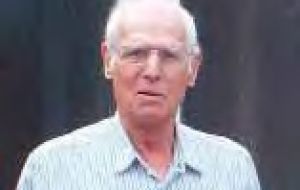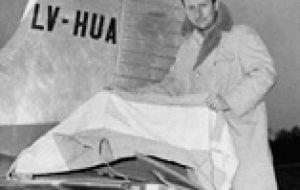MercoPress. South Atlantic News Agency
Fifty years since Falklands incursion and landing by Argentine light aircraft
 A recent photo of the ‘bystander’ Jim Shirtcliffe who received Fitzgerald’s note of protest.
A recent photo of the ‘bystander’ Jim Shirtcliffe who received Fitzgerald’s note of protest. This Monday is the fiftieth anniversary of an odd stunt by Argentine Cessna pilot Miguel Fitzgerald who landed his light aircraft on the Stanley racecourse, left a note of protest about the ‘illegal’ British occupation of the Falkland Islands, handed an Argentine flag to a bemused bystander, and flew away again.
Fitzgerald’s story was recorded by a number of newspapers in 1964, and he told them the idea of flying to the Islands was not a new one. Speaking of his exploits, he said in fact that pilots who flew from the Argentine Monte Grande airfield spoke of it often, although it was generally considered a kind of joke or prank idea. However it was one that had been in Fitzgerald’s head for fourteen years he told one interviewer.
His was not the first attempt though, in 1952, Aldo Comi along with Cesar Alvarez, an Aerodrome flight instructor, had departed from Rio Grande with a flight plan to Ushuaia. Once in the air they announced they were cancelling the flight plan filed and were heading to the Falklands; but weather prevented them landing.
They lost sight of the Islands and in a seven hour flight returned to Comodoro Rivadavia. But why September 1964?
Decolonization
When recording his exploits Fitzgerald said at that time the issue of the decolonization of territories was high on the UN agenda. His intention was to draw attention to this and raise sentiment in Argentina about Britain being, “caught in an act of unacceptable arrogance.”
Fitzgerald explained his intentions to colleague Siro Comi.
Comi was up for the adventure and offered ‘tickets’ for the order of modifications to the Cessna (185, 260 HP Registration LVHUA) which was referred to as ‘Luis Vernet’.
The plan was kept under wraps, although one Horacio Franco was aware of it; his role was to add fuel tanks to the aircraft with a total capacity of 200 liters Others who worked on the plane had an inkling a long important journey was to occur; an electric pump was added and a radioman called Quintana placed a long distance HF radio in the passenger seat.
Fitzgerald chose to offer his story, which would come out the moment he succeeded, to the journal ‘The Reason’ (La Razón) where his friend worked. He was very keen for publicity because if he lost his licence, he and his family would be in dire financial straits.
‘The Reason’ was less than enamored, but it was taken up by a new paper called ‘The Chronicle’. The young boss of the paper Héctor García was immediately enthusiastic.
“He offered me the tickets, gasoline, expenses and paid me to travel with me a photographer for the newspaper. But that trip was mine. I just wanted to make a note when I returned ... to cover me,” said Fitzgerald.
Fitzgerald chose September 8, half way through the couple of weeks that would be dedicated by the UN to discussing decolonization.
One day delayed, however, and all would be lost as an important football game was occurring on the 9th and nobody in Argentina would be interested in a maverick pilot when a championship final was occurring.
The trip begins
On September 6, Fitzgerald left Monte Grande Airfield bound for Olavarria, Buenos Aires, and then Trelew, Chubut. The next morning he went south through Comodoro Rivadavia and Caleta Olivia. An engine problem occurred and he landed in Pico Truncated before solving the problem at a Naval Air Base and Aeroclub. At Rio Gallegos he spoke to Ignacio Fernandez (Southern Commander and Manager) who he had entrusted with his plan in order to obtain necessary technical information and weather reports. There he also spoke to a radio operator with whom he would be in touch hourly during the journey.
The following day he was assisted in taking off secretly by Fernandez’ friend who happened to be an Argentine Air Force officer.
Fitzgerald eventually left Gallegos, “recalling the failed attempt of those who wanted to do this 10 years ago.”
In his first call to Rio Gallegos he reported that everything was normal: “I was at 8,000 feet …as I interned at sea, heading to the Islands, located five hundred and fifty miles from the coast of Argentina …. When a plane goes over the line of the coast and flies over the sea, everything changes.
The engine sounds different. The hood vibrates differently. It is necessary to ignore all that and concentrate on navigation, engine instruments and calculations. “
Fitzgerald could not swim so wore a lifebelt in case of having to ditch into the sea, but he knew in any case his chances of survival would be minimal.
The weather was cloudy on the way but guided by AM radio, Rio Gallegos and radio compass he eventually spotted some rocks. He decided to continue visually although visibility was no more than 150 meters. He informed Aeroclub Rio Gallegos he had found what he wanted and that he was crossing the, “Strait of San Carlos”.
He hoped to reach the Falklands by midday, “when hottest and most suitable for clouds - if any - were as high as possible.”
”Give this to your governor”
After three and one quarter hours of flight he broke through the clouds: “I felt sure of success.” He had reached the Islands with, “12 hours of flight range, so everything else was reduced to finding a suitable place to descend.”
Fitzgerald spotted Stanley, made two turns to show himself off to residents and sought a place to land. Having come to a halt on the racecourse and exited the plane with the flag he said people immediately began to arrive.
“One of them approached me. He thought I was lost. ‘Where do you come from? Do you need fuel?’
I thanked him and told him I did not need anything. It did not occur to him that I was Argentine, surely. I gave the proclamation and said, “Take, give this to your Governor.”
He then returned to the plane and flew back to Rio Gallegos, “not before making a few passes over the house of the said authority.”
Back in Stanley a surprised Jim Shirtcliffe, who had been employed building the first Dorran type house in the Ross Road West area, along with John Rowlands (father of Robert Rowlands) delivered the flag and letter to Government House and to the interim Governor the Honorable H Thomson. The letter was read and a report sent to London the following day (Penguin News).





Top Comments
Disclaimer & comment rules-

-

-

Read all commentsWow!
Sep 08th, 2014 - 05:55 am 0Argentinas own Lindbergh..
Filmus. Why isn't the “SPIRIT OF MALVINAS” in your museum?
funny thing is, he constantly refers to the falkland islands. Enough said.
Sep 08th, 2014 - 06:26 am 0Mind you, would love to see him do it again, or a fellow pilot. Not sure MP would even bother scrambling a jet, just shoot it down from the ground
and still.....The Falklands remain The Falklands and Falklanders remain Falklanders to this day, rather a pointless exercise, its a pity his fellow modern day argenscum didnt learn the lesson.
Sep 08th, 2014 - 07:31 am 0Self-Determination......thats what you need!
Commenting for this story is now closed.
If you have a Facebook account, become a fan and comment on our Facebook Page!